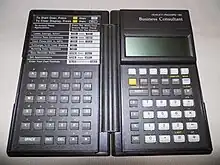HP-18C
The HP-18C was a Hewlett-Packard business calculator which was quickly followed by the very similar but greatly improved HP-19B. The HP-18C was HP's first RPL-based calculator internally,[1] even though this was not visible on user-level in this non user-programmable model. The user did have a solver (another HP first) available, but only had about 1.5 KB of continuous memory available to store equations.

A HP-18C
The calculator had many functions buried in a menu structure. The clamshell design was fairly robust, but the battery door is the shortcoming of this whole line; 18C, 19B, and 28C/S.
The HP-18C was introduced in June 1986.[1]
References
- Wickes, William C. (1988-10-01) [14–18 June 1988]. Forsely, Lawrence P. (ed.). RPL: A Mathematical Control Language. Proceedings of the 1988 Rochester Forth Conference: Programming Environments. Vol. 8. Rochester, New York, USA: Institute for Applied Forth Research, Inc., University of Rochester. pp. 27–32. ISBN 978-0-91459308-9. OCLC 839704944.
Several existing operating systems and languages were considered, but none could meet all of the design objectives. A new system was therefore developed, which merges the threaded interpretation of Forth with the functional approach of Lisp. The resulting operating system, known unofficially as RPL (for Reverse-Polish Lisp), made its first public appearance in June of 1986 in the HP-18C Business Consultant calculator.
(NB. This title is often cited as "RPL: A Mathematics Control Language". An excerpt is available at: )
Further reading
External links
- HP-18C on MyCalcDB (database about 1970s and 1980s pocket calculators)
- HP-18C at HP's Virtual Museum
This article is issued from Wikipedia. The text is licensed under Creative Commons - Attribution - Sharealike. Additional terms may apply for the media files.